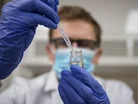Top 10 healthcare inventions that changed our way of life

The COVID-19 pandemic has accelerated trends and renewed focus on healthcare and the search for transformative solutions.
This is especially true for the coming generation of doctors, paramedics and epidemiologists, ready to provide care, diagnose disease, and prepare the world for the next pandemic. They will likely usher an era of culturally transformative healthcare advances, just like this list of Top 10 inventions that made life more comfortable - and longer - for all of us.
10. Soap
The soap industry was unscathed during the pandemic - keeping hands clean, soft and smelling sweet against the harshness of antibacterial liquid.
The ancient Sumerians of Mesopotamia (modern-day Iraq) used a mix of ashes and water as soap in 3000 BC.
9. Anna Coleman Ladd’s masks
The American sculptor used groundbreaking plastic surgery techniques to create facial masks for men whose faces had been scarred in the First World War.
She made casts and then crafted attachments of the damaged part of the face using painted copper and human hair, with the attachments affixed by glasses, allowing the soldiers to reintegrate with society.
8. Imodium
Dr. Janssen launched Imodium in 1973, to help those suffering from diarrhoea. The over the counter treatment is familiar with globetrotters, but tragically, it is not available to everyone. Diarrhoea is the second biggest killer of children under the age of five - and clean water is the cure.
7. X-ray
In 1895, German physicist Wilhelm Conrad Röntgen accidentally discovered the X-ray. After more research and development, Röntgen discovered that the X-rays could probe flesh, but not bones.
The X-ray created a window into the human body which used bones as a map, to help healthcare professionals discover what is going on inside.
6. Defibrillator
A defibrillator provides electric shocks to the heart of a patient experiencing cardiac arrest - when the heart ceases to function.
In 1930, Electrical Engineer William Kouwenhoven manufactured the external defibrillator. Then in 1947, cardiac surgeon Claude Beck first successfully used the debrillabulator in heart surgery.
5. Tampons
In 1931, the tampon was ‘alternative medicine’, but inventor Earle Haas was adamant that it would sell. Tampax founder Gertrude Tendrich saw its potential and helped women live more comfortably during their periods - from enjoying exercise more freely and having more confidence, its availability supported women as more ladies entered the workforce.
4. Blood transfusion
In 1818, British obstetrician James Blundell first performed a human blood transfusion, but the essential blood groups were not discovered until 1901, by Karl Landsteiner.
In the 1940s, the general public was first invited to donate their blood to help complete strangers in a medical emergency.
3. Condoms
Prior to the invention of modern condoms - linen, animal intestines and paper were used to prevent pregnancy and the transfer of sexually transmitted diseases. They failed - but the latex condoms used today (with 30bn sold annually) are helping to reduce HIV rates, decrease unplanned pregnancies and keep lovers safe and comfortable.
2. Organ donation
On the back of the science behind blood transfusions, organ donation was pioneered in 1954, by Dr Joseph E Murray.
Richard Herrick was dying and his brother Ronald agreed to a trailblazing operation to donate his kidney. The first successful organ transplant gave Richard eight more years of life.
Murray received a Nobel Prize "for discoveries concerning organ and cell transplantation in the treatment of human disease."
1. Vaccines
Like the X-ray, the vaccine was discovered by chance. Doctor Edward Jenner invited his gardener’s son, James, for the first vaccine experiment: Jenner scratched the boy’s arm and applied a sample of cowpox, from another cowpox patient, onto the scratches. James became ill for a few days and then recovered. Jenner then tested smallpox against the boy and James did not develop the disease. Jenner had created the first vaccine.
What else was number #1 going to be?!




